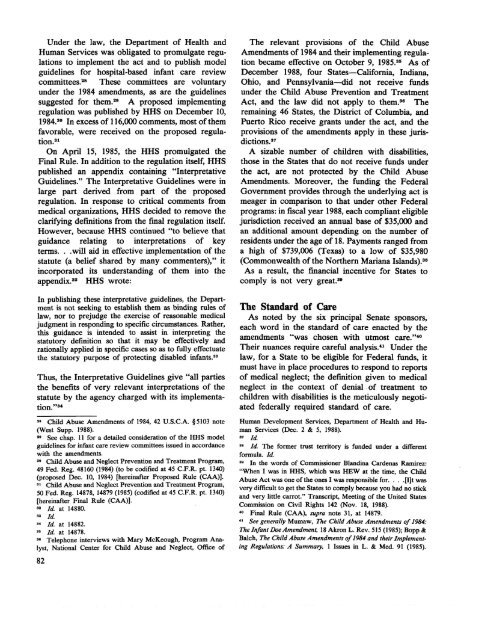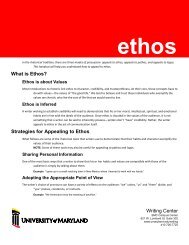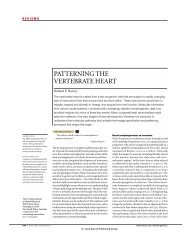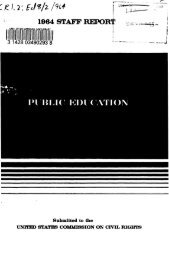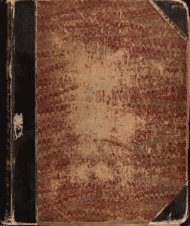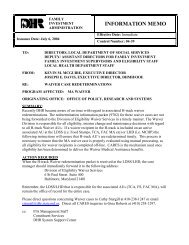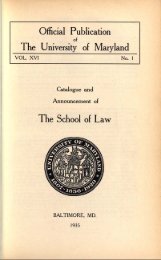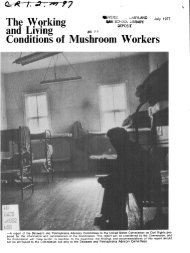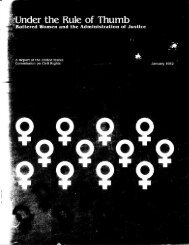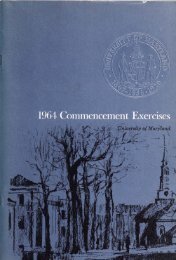Under the law, the Department <strong>of</strong> Health andHuman Services was obligated to promulgate regulationsto implement the act and to publish modelguidelines for hospital-based infant care reviewcommittees. 28 These committees are voluntaryunder the 1984 amendments, as are the guidelinessuggested for them. 29 A proposed implementingregulation was published by HHS on December 10,1984. 30 In excess <strong>of</strong> 116,000 comments, most <strong>of</strong> themfavorable, were received on the proposed regulation.31On April 15, 1985, the HHS promulgated theFinal Rule. In addition to the regulation itself, HHSpublished an appendix containing "InterpretativeGuidelines." The Interpretative Guidelines were inlarge part derived from part <strong>of</strong> the proposedregulation. In response to critical comments frommedical organizations, HHS decided to remove theclarifying definitions from the final regulation itself.However, because HHS continued "to believe thatguidance relating to interpretations <strong>of</strong> keyterms. . .will aid in effective implementation <strong>of</strong> thestatute (a belief shared by many commenters)," itincorporated its understanding <strong>of</strong> them into theappendix. 32 HHS wrote:In publishing these interpretative guidelines, the Departmentis not seeking to establish them as binding rules <strong>of</strong>law, nor to prejudge the exercise <strong>of</strong> reasonable medicaljudgment in responding to specific circumstances. Rather,this guidance is intended to assist in interpreting thestatutory definition so that it may be effectively andrationally applied in specific cases so as to fully effectuatethe statutory purpose <strong>of</strong> protecting disabled infants. 33Thus, the Interpretative Guidelines give "all partiesthe benefits <strong>of</strong> very relevant interpretations <strong>of</strong> thestatute by the agency charged with its implementation."3428ChDd Abuse Amendments <strong>of</strong> 1984, 42 U.S.C.A. §5103 note(West Supp. 1988).29See chap. 11 for a detailed consideration <strong>of</strong> the HHS modelguidelines for infant care review committees issued in accordancewith the amendments.30Child Abuse and Neglect Prevention and Treatment Program,49 Fed. Reg. 48160 (1984) (to be codified at 45 C.F.R. pt. 1340)(proposed Dec. 10, 1984) [hereinafter Proposed Rule (CAA)].31Child Abuse and Neglect Prevention and Treatment Program,50 Fed. Reg. 14878, 14879 (1985) (codified at 45 C.F.R. pt. 1340)[hereinafter Final Rule (CAA)].32Id. at 14880.33Id.34Id. at 14882.35Id. at 14878.36Telephone interviews with Mary McKeough, Program Analyst,National Center for Child Abuse and Neglect, Office <strong>of</strong>82The relevant provisions <strong>of</strong> the Child AbuseAmendments <strong>of</strong> 1984 and their implementing regulationbecame effective on October 9, 1985. 35 As <strong>of</strong>December 1988, four States—California, Indiana,Ohio, and Pennsylvania—did not receive fundsunder the Child Abuse Prevention and TreatmentAct, and the law did not apply to them. 36 Theremaining 46 States, the District <strong>of</strong> Columbia, andPuerto Rico receive grants under the act, and theprovisions <strong>of</strong> the amendments apply in these jurisdictions.37A sizable number <strong>of</strong> children with disabilities,those in the States that do not receive funds underthe act, are not protected by the Child AbuseAmendments. Moreover, the funding the FederalGovernment provides through the underlying act ismeager in comparison to that under other Federalprograms: in fiscal year 1988, each compliant eligiblejurisdiction received an annual base <strong>of</strong> $35,000 andan additional amount depending on the number <strong>of</strong>residents under the age <strong>of</strong> 18. Payments ranged froma high <strong>of</strong> $739,006 (Texas) to a low <strong>of</strong> $35,980(Commonwealth <strong>of</strong> the Northern Mariana Islands). 38As a result, the financial incentive for States tocomply is not very great. 39The Standard <strong>of</strong> CareAs noted by the six principal Senate sponsors,each word in the standard <strong>of</strong> care enacted by theamendments "was chosen with utmost care." 40Their nuances require careful analysis. 41 Under thelaw, for a State to be eligible for Federal funds, itmust have in place procedures to respond to reports<strong>of</strong> medical neglect; the definition given to medicalneglect in the context <strong>of</strong> denial <strong>of</strong> treatment tochildren with disabilities is the meticulously negotiatedfederally required standard <strong>of</strong> care.Human Development Services, Department <strong>of</strong> Health and HumanServices (Dec. 2 & 5, 1988).37Id.38Id. The former trust territory is funded under a differentformula. Id.39In the words <strong>of</strong> Commissioner Blandina Cardenas Ramirez:"When I was in HHS, which was HEW at the time, the ChildAbuse Act was one <strong>of</strong> the ones I was responsible for. . . .[Ijtwasvery difficult to get the States to comply because you had no stickand very little carrot." Transcript, Meeting <strong>of</strong> the United StatesCommission on Civil Rights 142 (Nov. 18, 1988).40Final Rule (CAA), supra note 31, at 14879.41See generally Mumaw, The Child Abuse Amendments <strong>of</strong> 1984:The Infant Doe Amendment, 18 Akron L. Rev. 515 (1985); Bopp &Balch, The Child Abuse Amendments <strong>of</strong> 1984 and their ImplementingRegulations: A Summary, 1 Issues in L. & Med. 91 (1985).
Perhaps the best short statement <strong>of</strong> the medicalstandard <strong>of</strong> care established by the Child AbuseAmendments <strong>of</strong> 1984 is found in the SupplementalInformation HHS published with the ProposedRule:[F]irst, all such disabled infants must under all circumstancesreceive appropriate nutrition, hydration and medication.Second, all such disabled infants must be givenmedically indicated treatment. Third, there are threeexceptions to the requirement that all disabled infants mustreceive treatment, or, stated in other terms, three circumstancesin which treatment is not considered "medicallyindicated." 42The required standard <strong>of</strong> care may be divided forthe purpose <strong>of</strong> convenient analysis into nine elements:(1) a disabled (2) infant (3) with a lifethreateningcondition (4) must always be givennutrition, hydration, and medication (5) and mustnormally be given the treatment most likely tocorrect or ameliorate the condition (maximal treatment)(6) based upon the reasonable medical judgment<strong>of</strong> the treating physician, (7) but the maximaltreatment rule is not applicable in three situations:when the child is "chronically and irreversiblycomatose," (8) when maximal treatment would befutile in saving the child's life for long, and (9) when"provision <strong>of</strong> such treatment would be virtuallyfutile in terms <strong>of</strong> the survival <strong>of</strong> the infant and thetreatment itself under such circumstances would beinhumane." 43Disabled"Disabled" is not expressly defined in the statute,its implementing regulations, or the HHS InterpretativeGuidelines. However, some light is cast upon its42Proposed Rule (CAA), supra note 30, at 48163.43The statute prohibits "withholding <strong>of</strong> medically indicatedtreatment from disabled infants with life-threatening conditions,"42 U.S.C.A. §51O3(b)(2)(K) (West Supp. 1988), and defines thekey term as follows:[T]he term "withholding <strong>of</strong> medically indicated treatment"means the failure to respond to the infant's life-threateningconditions by providing treatment (including appropriatenutrition, hydration, and medication) which, in the treatingphysician's or physicians' reasonable medical judgment, willbe most likely to be effective in ameliorating or correcting allsuch conditions, except that the term does not include thefailure to provide treatment (other than appropriate nutrition,hydration, or medication) to an infant when, in thetreating physician's or physicians' reasonable medical judgment,(A) the infant is chronically and irreversibly comatose;(B) the provision <strong>of</strong> such treatment would (i) merely prolongdying, (ii) not be effective in ameliorating or correcting all <strong>of</strong>the infant's life-threatening conditions, or (iii) otherwise befutile in terms <strong>of</strong> the survival <strong>of</strong> the infant; or (C) themeaning by the legislative history. The originalformulation <strong>of</strong> what became "disabled infants withlife-threatening conditions" in the statute was "infantsat risk with life-threatening congenital impairments"in the House-passed bill. 44 Concern wasexpressed that this language would be interpreted tocover only those disabled infants whose life-threateningcondition arose directly from a congenitalimpairment. 45 The enacted language clarifies thatthe 1984 amendments protect all infants with adisability, including those who develop a disabilityafter birth, from withholding <strong>of</strong> medically indicatedtreatment for any life-threatening condition, regardless<strong>of</strong> whether the condition is related to thedisability.Model Procedures developed under a Federalgrant by the American Bar Association's Commissionon the Mentally Disabled and the NationalLegal Resource Center for Child Advocacy andProtection suggest the following meaning for theterm "disabled":"Disabled infant" means an infant with a physical ormental impairment which substantially limits or holds thereasonable prospect <strong>of</strong> in the future substantially limitingone or more major life activities. "Major life activities"include functions such as, but not limited to, breathing,seeing, hearing, walking, caring for one's self, performingmanual tasks, learning and working. 46The Model Procedures explain that this definition isbased on the definitions <strong>of</strong> "[h]andicapped person,""[p]hysical or mental impairment," and "[m]ajor lifeactivities" in the implementing regulations for section504 <strong>of</strong> the Rehabilitation Act <strong>of</strong> 1973, 47 exceptprovision <strong>of</strong> such treatment would be virtually futile in terms<strong>of</strong> the survival <strong>of</strong> the infant and the treatment itself undersuch circumstances would be inhumane.Id. §5102(3).44The House Committee report interpreted this original languageto mean that those to be protected by the law were infantswho are "born with a medically-identifiable handicapping conditionand a life-threatening condition, the latter <strong>of</strong> which requiresmedical intervention in order to increase the infant's changes [sic]<strong>of</strong> survival." H.R. Rep. No. 159, 98th Cong., 1st Sess. 2 (1983).45Bopp & Balch, supra note 41, at 107.48Nicholson, Horowitz & Parry, Model Procedures for ChildProtective Service Agencies Responding to Reports <strong>of</strong> WithholdingMedically Indicated Treatment From Disabled Infants With Life-Threatening Conditions, 10 Mental & Physical Disability L. Rep.220, 228 (1986) [hereinafter Model Procedures].47Id. These definitions are found in 45 C.F.R. §84.3 (j) (1987).They are not part <strong>of</strong> the "Baby Doe" regulations enjoined by theU.S. Supreme Court in Bowen v. Am. Hosp. Ass'n, 476 U.S. 610(1986), but are part <strong>of</strong> the preexisting 1977 regulation implement-83
- Page 1 and 2:
MedicalDiscriminationAgainstChildre
- Page 3 and 4:
idments • Section 504 • Medical
- Page 5:
LETTER OF TRANSMITTALThe PresidentT
- Page 9 and 10:
CONTENTSExecutive Summary 11. Funda
- Page 11:
12. The Performance of the Federal
- Page 14 and 15:
• The role of economic considerat
- Page 16 and 17:
disabilities at the time that the c
- Page 19 and 20:
generated by health care personnel
- Page 21:
ing how they would obtain medical r
- Page 24 and 25:
The Commission sees several advanta
- Page 26 and 27:
acquiescence in the death or elimin
- Page 28 and 29:
Services of the Department of Healt
- Page 30 and 31:
Chapter 1Fundamental Rights: An Int
- Page 32 and 33:
Carlton Johnson was evaluated by a
- Page 34 and 35:
"that Mr. and Mrs. Doe, after havin
- Page 36 and 37:
American Coalition of Citizens with
- Page 38 and 39:
Chapter 2The Physician-Parent Relat
- Page 40 and 41:
In all but a few cases, the parents
- Page 42 and 43:
the family, and the family went alo
- Page 44 and 45: Chapter 3The Role of Quality of Lif
- Page 47: transition from education to employ
- Page 50 and 51: tion programs can become productive
- Page 52 and 53: unsuccessful efforts of a private a
- Page 54 and 55: [S]ince I have been at Children's M
- Page 56 and 57: Another survey by Siperstein, Wolra
- Page 58 and 59: of life with a child who is disable
- Page 60 and 61: Chapter 4The Role of Economic Consi
- Page 62 and 63: ©TABLE 4.1Pediatricians' Responses
- Page 64 and 65: • The differences in average cost
- Page 66 and 67: FIGURE 4.1Comparative Costs of Inst
- Page 68 and 69: Chapter 5State LawWhat is the law g
- Page 70 and 71: Like all authority. . .parental aut
- Page 72 and 73: This decision, however, was promptl
- Page 74 and 75: No otherwise qualified handicapped
- Page 76 and 77: Bloomington's Infant Doe in April 1
- Page 78 and 79: ONONTABLE 6.1Physician's assessment
- Page 80 and 81: Essentially, HHS interpreted the su
- Page 82 and 83: Final 504 RuleHHS received nearly 1
- Page 84 and 85: lifesaving operations to close her
- Page 86 and 87: any further implementation of the F
- Page 88 and 89: handicapped infants might violate S
- Page 90 and 91: the provision does cover discrimina
- Page 92 and 93: of the infants. The review mechanis
- Page 96 and 97: that "the phrase 'or holds the reas
- Page 98 and 99: allows an infant to be denied nutri
- Page 100 and 101: avoid the explicit standards set fo
- Page 102 and 103: (as opposed to the far) future, the
- Page 104 and 105: It was recognized, therefore, that
- Page 106 and 107: als with the particular disability
- Page 108 and 109: cared for. They are thus different,
- Page 110 and 111: medical advice. Given the magnitude
- Page 112 and 113: tions at all regarding the subject
- Page 114 and 115: strates that there is a grave dange
- Page 116 and 117: Disincentives to Whistle BlowingDen
- Page 118 and 119: Using a cumulative scaling procedur
- Page 120 and 121: Of that 300 we targeted, approximat
- Page 122 and 123: Conclusionphysicians set forth in t
- Page 124 and 125: taking place when a report of suspe
- Page 126 and 127: where the parents say "the child fe
- Page 128 and 129: Nevertheless, the organization oppo
- Page 130 and 131: Chapter 11The Role and Performance
- Page 132 and 133: a member of the American Academy of
- Page 134 and 135: possibilities that "will be most li
- Page 136 and 137: clearly indicate that the committee
- Page 138 and 139: Reviewing the first 30 months of th
- Page 140 and 141: Webster's defines "suspected" as "t
- Page 142 and 143: Chapter 12The Performance of the Fe
- Page 144 and 145:
The baby's doctor, E. Laurence Hode
- Page 146 and 147:
to achieve a reasonable life". . .w
- Page 148 and 149:
an unmarried mother receiving welfa
- Page 150 and 151:
can be sure all appropriate actions
- Page 152 and 153:
inquiries to determine whether they
- Page 154 and 155:
Chapter 13The Protection and Advoca
- Page 156 and 157:
authority to conduct retrospective
- Page 158 and 159:
facility that uses such a committee
- Page 160 and 161:
Chapter 14Findings and Recommendati
- Page 162 and 163:
as the coordination and development
- Page 164 and 165:
in the advisory process who is conc
- Page 166 and 167:
A Dissenting View on the Report Med
- Page 168 and 169:
arts) to depend upon knowledge of h
- Page 170 and 171:
Attachments to Statement of William
- Page 172 and 173:
medical facility. Considerations su
- Page 174 and 175:
Fund for the Improvement of Postsec
- Page 176 and 177:
eports such as Kopelman et al. demo
- Page 178 and 179:
Appendix 1EXPOSING OUR CHILDREN, EX
- Page 180 and 181:
abilities or functions, they are de
- Page 182 and 183:
My principal reason for objecting t
- Page 184 and 185:
I derive this hint from the many co
- Page 186 and 187:
moral distinction. A girl is a huma
- Page 188 and 189:
Appendix 2SURVEY OFSTATE BABY DOE P
- Page 190 and 191:
insure the immediate referral of po
- Page 192 and 193:
Hospital Liaisons Designated in Mos
- Page 194 and 195:
BABY DOE COMPARED WITH REGULAR CPS
- Page 196 and 197:
We also asked state CPS offices wha
- Page 198 and 199:
Limited information was available o
- Page 200 and 201:
one-quarter felt that baby doe case
- Page 202 and 203:
Appendix 3INFANT CARE REVIEW COMMIT
- Page 204 and 205:
and guidelines concerning the withh
- Page 206 and 207:
treated to assure the prompt ^repor
- Page 208 and 209:
3. Educating Staff and FamiliesThre
- Page 210 and 211:
One of the 10 ethics committees vis
- Page 212 and 213:
asphyxiation during the birth proce
- Page 214 and 215:
Prospective Review -- Each committe
- Page 216 and 217:
OBSERVATIONSThe inspection found th
- Page 218 and 219:
May 1, 1989Page 2The Commission adv
- Page 220 and 221:
Doe 1 admitted on the record of the
- Page 222 and 223:
tion is the basis for failure to tr
- Page 224:
her (much appreciated) vote for thi


